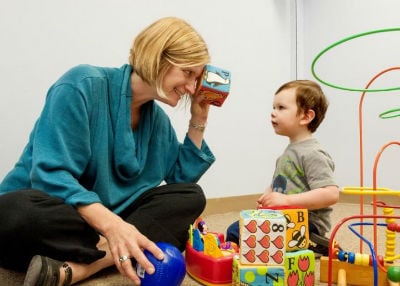MRIs have been used in a revolutionary study to predict if infants will later develop autism. The disorder has only been identifiable in children of 24 months of age. Now, research positively shows that signs of autism can be detectible in babies during their first year of life.
The study published today in
Nature is the first to demonstrate whether an infant – whose older siblings have autism – will be diagnosed with the disorder at a later stage.
MRIs were used to image the infants’ brains. This was followed by an analysis of measurements by a computer algorithm to correctly predict symptoms of Autism Spectrum Disorder (ASD). Researchers were able to accurately predict 80 percent of those infants who would later present symptoms of the disorder at the age of two years old.
Annette Estes, left, plays with 2-year-old Caellum Ortiz at the UW Autism Center.
Image Credit: Kathryn Sauber
Senior author Joseph Piven, MD, the Thomas E. Castelloe Distinguished Professor of Psychiatry at the University of North Carolina-Chapel Hill said: “Our study shows that early brain development biomarkers could be very useful in identifying babies at the highest risk for autism before behavioral symptoms emerge. Typically, the earliest an autism diagnosis can be made is between ages two and three. But for babies with older autistic siblings, our imaging approach may help predict during the first year of life which babies are most likely to receive an autism diagnosis at 24 months."
The research project conducted at the Carolina Institute for Developmental Disabilities (CIDD) at the University of North Carolina and more clinical sites has so far, delivered positive results. Researchers from around the U.S. conducted MRI scans on hundreds of babies at six,12, and 24 months of age.
The study found that babies between 6–12 months, who developed autism, experienced a hyper-expansion of brain surface area. The increased growth rate of surface area in the child’s first year has been associated with the overall brain overgrowth as seen in an autistic child’s second year of life.
Data from these MRI including brain volume, surface area, cortical thickness at 6 and 12 months of age, and sex of the infants were then identified by a computer program. The algorithm classified which babies were most likely to meet the criteria for autism at 24 months of age.
This algorithm was then used to study more participants. The study showed that the brain differences of infants (at 6 and 12 months) with older siblings with autism accurately predicted eight out of ten infants who would later show signs of autism at 24 months of age.
Piven said: "This means we potentially can identify infants who will later develop autism, before the symptoms of autism begin to consolidate into a diagnosis,"
This clinical test proves to be useful for parents who wish to find out if their second child is also likely to be diagnosed with autism.
The aim of this study would be to intervene 'pre-symptomatically' before a child starts showing exact symptoms of autism at 24 months of age. The effect of such interventions could then be examined on the child before actual symptoms of autism develop. This in turn, can potentially improve outcomes.
Autism is a disorder, affecting millions of people worldwide and is characterised by having difficulties in social interaction, verbal and nonverbal communication and repetitive behaviors. In the United States alone, it has been estimated that one of 68 children develop autism. More specifically, infants with older siblings with autism, are more at risk with a chance of it affecting 20 out of every 100 births.
With this research underway, it may now be possible to predict autism during a child’s first year of life, something that has not been successful until now.
"We don't have such a tool yet," said UW professor of speech and hearing sciences Annette Estes, who is also director of the UW Autism Center and a research affiliate at the UW Center on Human Development and Disability. "But if we did, parents of high-risk infants wouldn't need to wait for a diagnosis of ASD at 2, 3 or even 4 years and researchers could start developing interventions to prevent these children from falling behind in social and communication skills."
Image Credit: Pixabay
























